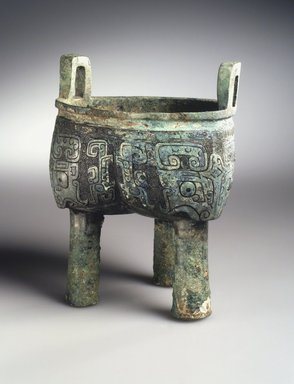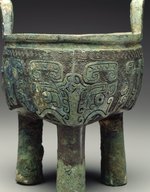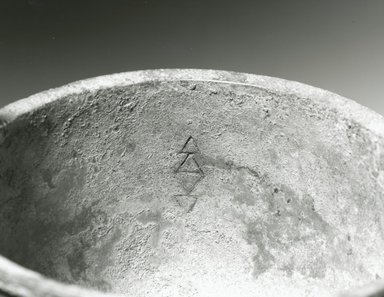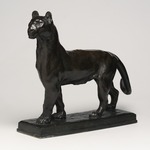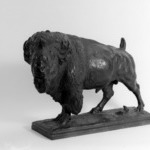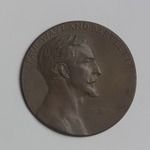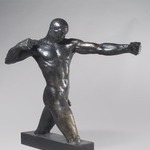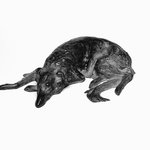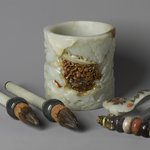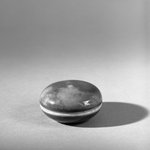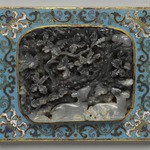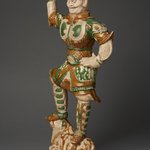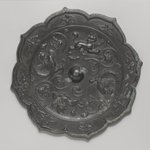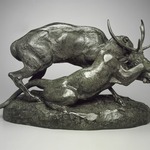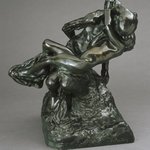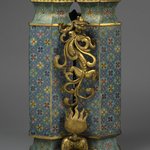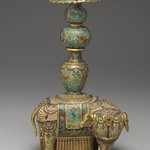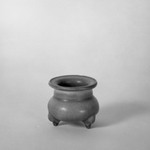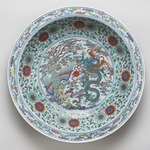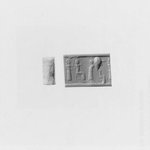Ritual Tripod Vessel (Ding)
Asian Art
On View: Asian Galleries, West, 2nd floor (China)
Bronze ding vessels were cooking pots reserved for offerings of food to ancestors during the Shang through the Han (206 B.C.E.–220 C.E.) dynasties. Using bronze signified that a vessel was a ritual object of great importance, as the ruler controlled access to both the copper and tin that were mined to make the bronze alloy, as well as the workshops that cast the vessels. On this vessel, black inlay is used to highlight the animal mask (taotie) on the sides, particularly the deep pupils of the eyes, against a dense ground of tight spirals known as leiwen (“thunder”). The clan sign of the family authorized by the ruler to cast the vessel is found on the vessel’s interior wall.
MEDIUM
Cast bronze with inlay
DATES
12th–11th century B.C.E.
DYNASTY
Shang to Western Zhou Dynasty
PERIOD
Late Shang to Early Western Zhou Dynasty
DIMENSIONS
8 7/16 x 6 7/16 x 6 3/8 in. (21.4 x 16.4 x 16.2cm)
(show scale)
ACCESSION NUMBER
1997.178
CREDIT LINE
Anonymous gift
CATALOGUE DESCRIPTION
A bronze ritual vessel, known as a ding, in the form of a rounded bowl on three legs, the bowl of a distinctive three lobed form. The placement of the two raised handles and the location of the clan sign on the inside back wall of the bowl determine the orientation of the vessel. In contrast to round-bellied ding vessels in which decoration is usually centered on an axis between the legs and articulated by low flanges, the present ding is one of a distinct group on which the taotie mask design is centered over the legs. The mask is centered on a subtly raised ridge over the leg while the secondary animals that form the ears of the taotie continue on the curving form of the individual lobe, articulating the swelling curves of the surface of the bowl. The sturdy, slightly splayed cylindrical legs, approx. 3 3/8 long, taper slightly from the foot to the undecorated bottom of the bowl. Mold marks are visible on the exterior, in the center of each taotie mask, and on the underside of the bowl.
The design is cast in low relief on the sides of the bowl and forms a distinct range between the undecorated cove under the squared, flaring lip and the undecorated bottom of the bowl. The design consists of taoie masks and secondary animals in smooth, low relief against a dense ground of squared spiral leiwen designs. The front-facing taotie mask has minor, intaglio details that are generally symmetrical around the center axis. The main features consist of a snout, wide upper jaw with short spiral extensions, the curved fangs incised in the same manner as the background leiwen and just visible below the jaw, the head with circular, staring eyes rising slightly above the surface, and spiraling C-shaped horns. The secondary animals, tentatively identified as kui dragons are placed head down and depicted in profile with an open mouth with a large curled snout, a single truncated S-shaped horn behind the head; with two short, square legs; and the tail raised in a spiral over the back.
The bronze displays a varied patina ranging from smooth, gray green surface of the original casting to thicker encrustation of bright blue green copper compounds and deep blue malachite, with smaller areas of light tan patina. There are also encrustations of earth from burial. A matte black material fills large portions of the intaglio areas of leiwen ground as well as the deep central pupils of the eyes of the tao tie masks and the secondary animals. Large amounts of the same material adhere to the bottom outside of the bowl, especially at the joins between the bowl and the legs and in the center of the bowl. Areas of patina and burial encrustation on the interior if the bowl is marked with parallel ridges may indicate the remains of textiles present at the time of burial. Patina and corrosion on the legs may possibly indicate repairs or restoration at an undetermined time in the past.
Condition: The ding is intact with no clear signs of repair or restoration. (The donor indicated that he did not clean or restore the object in any way while it was in his possession) Areas of the patina and burial encrustation are loose and continue to flake off in minute pieces, especially from the legs and inside of the bowl. Two areas require further investigation to determine their exact condition: the two left hand cheek of the taotie mask over the back leg, where there is an area of whitish patina and some evidence of loss to the body of metal; and the small area of distinctly squared off leiwen pattern to the left of the mold mark between the horns of the taotie over the left front leg. (This area may be a repair, possibly from the time of the original casting.)
From Accession Card
CAPTION
Ritual Tripod Vessel (Ding), 12th–11th century B.C.E. Cast bronze with inlay, 8 7/16 x 6 7/16 x 6 3/8 in. (21.4 x 16.4 x 16.2cm). Brooklyn Museum, Anonymous gift, 1997.178. Creative Commons-BY (Photo: Brooklyn Museum, 1997.178_SL4.jpg)
IMAGE
overall, 1997.178_SL4.jpg. Brooklyn Museum photograph, 2014
"CUR" at the beginning of an image file name means that the image was created by a curatorial staff member. These study images may be digital point-and-shoot photographs, when we don\'t yet have high-quality studio photography, or they may be scans of older negatives, slides, or photographic prints, providing historical documentation of the object.
RIGHTS STATEMENT
Creative Commons-BY
You may download and use Brooklyn Museum images of this three-dimensional work in accordance with a
Creative Commons license. Fair use, as understood under the United States Copyright Act, may also apply.
Please include caption information from this page and credit the Brooklyn Museum. If you need a high resolution file, please fill out our online
application form (charges apply).
For further information about copyright, we recommend resources at the
United States Library of Congress,
Cornell University,
Copyright and Cultural Institutions: Guidelines for U.S. Libraries, Archives, and Museums, and
Copyright Watch.
For more information about the Museum's rights project, including how rights types are assigned, please see our
blog posts on copyright.
If you have any information regarding this work and rights to it, please contact
copyright@brooklynmuseum.org.
RECORD COMPLETENESS
Not every record you will find here is complete. More information is available for some works than for others, and some entries have been updated more recently. Records are frequently reviewed and revised, and
we welcome any additional information you might have.



